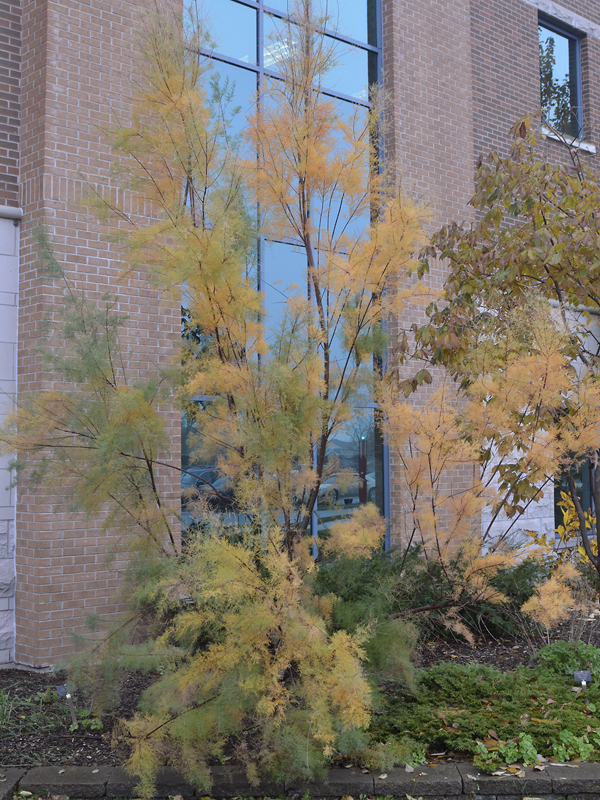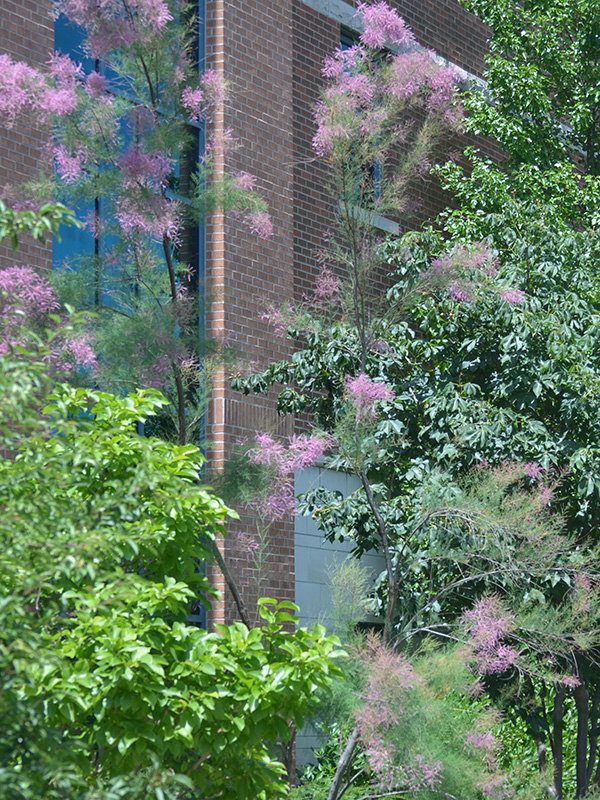
Woody > Tamarix > Tamarix ramosissima > Tamarix ramosissima
Tamarix ramosissima
Saltcedar or Five-stamen Tamarix.
Origin: Native to southeastern Europe and central Asia.

"
Tamarix ramosissima or saltcedar is appropriately named as it's mature leaves and stems secrete salt, this along with its consumption of large amounts of water make it a very aggressive colonizer that will outcompete other plants near it. Due to the aggressive nature of this plant it, in many states is listed as an invasive weed, though in the Canadian provinces it hasn't been much of a problem. In many of the warmer American states it is subject to eradication programs and is of environmental concern. Though it may be aesthetically pleasing in leaf, its coarse texture in the winter months while defoliated and invasive nature make it a poor choice for most landscapes, and a terrible choice in warmer climates. Though it can be used to effectively slow erosion, and can grow well in saline soils and hence might warrant use in dune environments its use should be explored with caution.
Michael Pascoe, NDP., ODH., CLT., MSc. (Plant Conservation)
"
| Family |
| Tamaricaceae |
| Genus |
| Tamarix |
| Species |
| ramosissima |
| Category |
| Woody |
| Type |
| Tree (deciduous), Shrub (deciduous) |
| Pronunciation |
| USDA Hardiness Zone |
| 3-8 |
| Canadian Hardiness Zone |
| 2-8 |
| RHS Hardiness Zone |
| H7 |
| Temperature (°C) |
| -40 |
| Temperature (°F) |
| -40 |
| Height |
| 3-4.5 m |
| Spread |
| 2.5-4 m |
| General Description |
| Saltcedar are the hardiest species of Tamarix, very invasive in warmer climates and consume large amounts of water through its long taproot. Mature stems and leaves secrete salt which will inhibit the growth of other nearby plants and as such are aggressive colonizers where suitable conditions permit, Its flowers and foliage are aesthetically pleasing thus giving it limited use in the cultured landscape. |
| Landscape |
| Saltcedar is used for it's fine-textured, light green/grey foliage with scale-like like leaves that give it a feathery appearance, it's reddish arching branches, as well as it's flowers, which bloom in racemes of pink flowers. Aesthetically it has a great texture when in bloom, but loses that appeal when defoliated. It is frequently used in places with saline or poor soils since it thrives in such environs. |
| Cultivation |
| Though saltcedar has a wide range of growing tolerance it is often used in saline and poor soils. However it grows best in sand-loam, in well drained soils in full sun. |
| Shape |
| A very loose open shrub to small, but ungainly tree. |
| Growth |
| Fast |
| ID Characteristic |
| Tamarix ramosissima is identifiable from other members of its genus due to it's very open form as well as the 5-petaled, 5-sepaled flowers borne on slender racemes. Its slender, reddish, elongated branches, light green/gray scale like foliage can also be used as an indicator. |
| Pests |
| Saltcedar is susceptible to powdery mildew, root rot, wood rot, cankers, and scales. |
| Habitat |
| Though its native to southeastern Europe and central Asia since it’s been introduced elsewhere saltcedar has done incredibly well, even becoming invasive in warmer climates. It is now found naturalized growing on riverbanks, in ditches, flood plains, waste areas, and along rivers and streams in many places in North America. |
| Bark/Stem Description |
| As a fast growing plant saltcedar's bark is soft and easy to break, is smooth and reddish-brown in colour on younger branches turning grey on older wood. |
| Flower/Leaf Bud Description |
| Saltcedar buds are small, sessile, rounded, and are compressed against the twig and generally have 3 exposed scales. |
| Leaf Description |
| It has alternate, simple, 3 mm long, lanceolate leaves, that are usually scale-like in appearance, and are a light green to grey colour. |
| Flower Description |
| T. ramosissima has perfect, pink or white flowers, that are composed of 5 petals and 5 sepals, held in dense racemes that 2.5 -7.5 cm long formed in large, terminal panicles. |
| Fruit Description |
| The seed 2-4 mm long seed capsules contains many seed, with each seed being .45 mm long and 0.17 mm wide. These seeds have unicellular hairs 2 mm long at the apical end. |
| Colour Description |
| The flowers are generally a light pink, though sometimes white, it's bark and branches are a reddish-brown to grey, and it's foliage is a light green to grey colour. Saltcedar buds are the colour of the flower (pink or white) and the fruit capsules are a greenish-brown colour. |
| Texture Description |
| Saltcedar has a fine-textured foliage, but is very coarse at leaf-drop. |
| Notable Specimens |
| Bridge of Flowers, Shelburne Falls, Massachusetts., United States of America. The A. M. Cuddy Gardens, Strathroy, Ontario, Canada. |
| Propagation |
| Saltcedar seeds usually germinate within 24 hours after imbibing water. There is no pretreatment necessary. |

